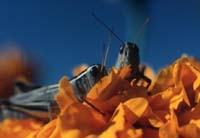Required Readings
Science in Action 7
pages 55-61
or
Science Focus 7
pages 52-54
|
|
Living things interact with abiotic and biotic factors within their niche. The factors can be symbiotic in nature such as a bee and a flower. The bee obtains the nectar while the flower is pollinated by the pollen from another flower.
Bioinvasion
Relationships within this ecosystem can be challenged or changed as new species are introduced. The zebra mussel was introduced into the Great Lakes resulting in the extermination of the shellfish industry. At the time the zebra mussel had no enemies in the lakes. Visit this link and read about the affect that these creatures have had.
Predation
Imagine you want to do an experiment on population growth. You find a deserted island in the middle of the South Pacific Ocean. The island is lush with vegetation and there happens to be no predators or rabbits on this island. So you drop off two male and two female rabbits on the island and you leave.
| In one year, you come back to the island. To your delight, your rabbits are doing well. They have reproduced and now the number of rabbits is at 55. They all appear to be healthy and there is lots of food on the island, so you leave. |
 |
When you return in another year, you are astounded to find the rabbits have been breeding rapidly. During this visit you counted 967 rabbits on the island, but you start to wonder if the food supply will be able to sustain this population growth of rabbits. It is possible for a population to increase so rapidly that it will grow beyond the carrying capacity of the environment. If this happens, the population usually experiences a crash, with large numbers of individuals dying in a short period of time. Such a rapid increase in the population might cause a long term decrease in the carrying capacity of the island. Such a large population might be so desperate for food that it might strip the plants bare, delaying their ability to regrow. This could reduce the carrying capacity of the environment below its former level and limit for many years the number of individuals that could live in the environment. You are now worried about the effect your experiment may be having on the environment. But it is too difficult to round up all the rabbits, so you let nature play its course.
 |
When you return at the end of the third year, you find the population of rabbits has decreased to 450 rabbits. As expected, the carrying capacity of the island was reached and large numbers of rabbits died off over the last year. There appears to be much less grass on the island. At this point you realize, the island has a limit to the number of rabbits it can feed. Some of the rabbits have starved, others have died from disease. |
To continue with the study you come back to the island the next year. There are now 500 rabbits living on the island. Again you find the population to be at approximately the same numbers as the year before. You concluded the population has now stablized, the number of deaths due to starvation and disease is approximately the same as the amount of births. Since there are no predators on the island, the key factors for limiting the population is the food supply. It determines the island's carrying capacity.
| In the fifth year of the experiment, you return to the island and observe that once again the rabbit population is at 425 rabbits. A fairly stable population. Now that your rabbit population has stabilized, you want to expand your experiment and add a predator to the island that consumes rabbits as its primary food source. A male and female coyote are brought to the island. |
 |
Consider what will happen to the coyote and rabbit populations on the island in the sixth, seventh, eight, ninth, and tenth years of the experiment.
|
|























